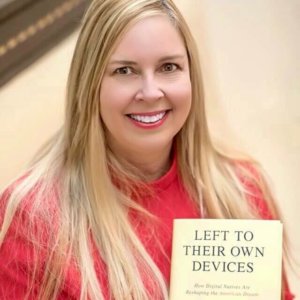Coming Untethered: The Unintended Consequences of Hyper Digitalization

A leading researcher on the social impacts of technology, Dr. Julie Albright, lecturer in Systems Architecting and Engineering at USC Viterbi School of Engineering, believes we’ve come to a point of imbalance. After centuries of connecting with each other face-to-face and with nature, we’ve come to rely on digital connections in every aspect of our lives. In just a few years, we’ve completely moved away from these offline relationships, creating a new paradigm that we must grapple with to rebalance ourselves and restabilize our society.
What is the problem you’re trying to solve?
We’re in a transitional period between analog and digital. Socially, people are pulling away from traditional social processes and structures, like getting married or buying a home, which are some of the traditional markers of adulthood. Now they’re hyper attaching to digital technologies. It’s creating a wave of unintended social consequences that people are still grappling with.
Why is detaching a bad thing?

Julie Albright. PHOTO/KRIS KRUG
The notion is, you have all this freedom: freedom to date anyone you want, freedom to work anywhere you want, freedom to move anywhere. The problem is all this freedom comes with a cost, and the costs are unforeseen things like loneliness, which is on the rise, or we have the highest rates of anxiety and depression in colleges in 30 years. So, there are unintended consequences of coming untethered from all these stabilizing social structures.
How do we address these unintended consequences?
The challenge is, how can we create new anchoring points, particularly for young digital natives unhooked from the things that were keeping them stabilized—things like church or, again, marriages. So, how do we create these? One opportunity is the workplace. Maybe that’s the place that has to somehow create community or support in a new way, even though that’s not its traditional role or job.
What is the implication at an industry-level of this changing landscape?
Our social lives, and increasingly, our physical world is connected and run by digital infrastructure be it the lighting, or the heating and cooling or, as we have smart buildings—our locks. Everything will be run by a digital infrastructure. We need secure, strong, stable, digital infrastructures for these reasons.
For example, the energy grid was almost purely an analog thing. Now, with the smart grid, you have a digital layer, which means there’s a closer connection between the utility and the consumer. You need new skills in this world as the Internet of Things spreads out—you need more understanding of the behavioral and social aspects of things than you did before.
Can technology help us disconnect from our devices and reconvene with each other?
Technologies can bring people together. For example, there’s a group called Brick, referring to when your phone is dead. They’re using technology to bring people together, but then they’re setting their phones aside for an hour to, for example, sing as a collective. There are ways that I think technology can facilitate reconnecting people. But it’s just, you have to have an awareness that we need that first.
This is where we’re at; we’re just starting to become aware that there’s something missing that we need to reconnect with in terms of what it means to be human.
Dr. Albright is currently a lecturer in the departments of Applied Psychology and Systems Architecting and Engineering at USC, where she teaches master’s level courses on the Psychology of Interactive Technologies and Sustainable Infrastructure respectively. In partnership with Infrastructure Masons, a professional group of technologists and business leaders, she is developing a course on digital infrastructure, which she hopes to bring to USC Viterbi.
Her book, Left to Their Own Devices: How Digital Natives are Reshaping the American Dream, is now available.
Published on April 18th, 2019
Last updated on May 16th, 2024